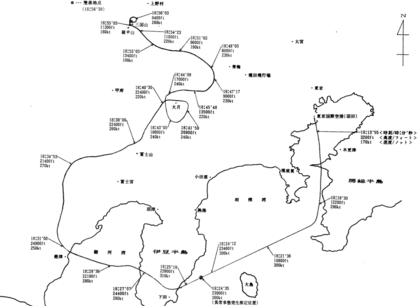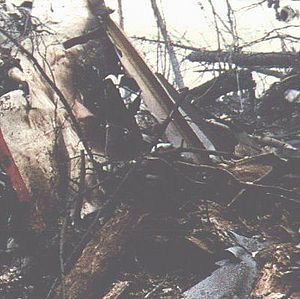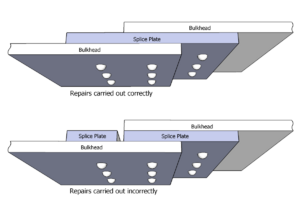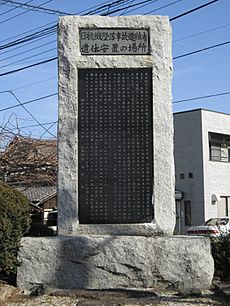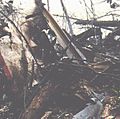Japan Air Lines Flight 123 facts for kids
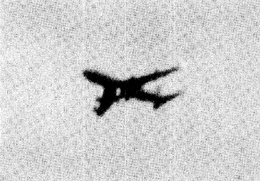
The damaged plane about 6 minutes before it crashed. Its tail fin is mostly gone.
|
|
| Accident summary | |
|---|---|
| Date | August 12, 1985 |
| Summary | Crashed after its tail broke apart and all hydraulic systems failed |
| Place | Mount Takamagahara, Japan 36°0′5″N 138°41′38″E / 36.00139°N 138.69389°E |
| Passengers | 509 |
| Crew | 15 |
| Injuries (non-fatal) | 4 |
| Fatalities | 520 |
| Survivors | 4 |
| Aircraft type | Boeing 747SR-46 |
| Airline/user | Japan Air Lines |
| Registration | JA8119 |
| Flew from | Haneda Airport, Tokyo, Japan |
| Flying to | Itami Airport, Osaka, Japan |
Japan Air Lines Flight 123 was a regular flight from Tokyo to Osaka, Japan. On August 12, 1985, the Boeing 747 plane had a major problem. Its tail broke apart and the cabin lost air pressure. This happened 12 minutes after takeoff.
The pilots tried to control the plane for another 32 minutes. But the plane crashed near Mount Takamagahara, about 100 kilometers (62 miles) from Tokyo.
The plane was carrying 524 people. All 15 crew members died. Out of 509 passengers, 505 died. Only four people survived the crash. This accident is the deadliest single-aircraft accident in history.
Investigators later found out what caused the crash. A repair done by Boeing seven years earlier was faulty. This repair was made after the plane's tail hit the runway. When the faulty repair failed, it caused the tail to break off. It also destroyed the plane's hydraulic systems. This meant the pilots could not control the plane anymore.
Contents
Understanding the Accident: Background Facts
The Aircraft: Boeing 747SR-46
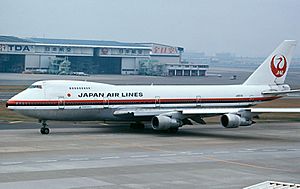
The plane was a Boeing 747SR-46. Its registration number was JA8119. It was built in 1974 for Japan Air Lines.
Before the accident, the plane had flown for over 25,000 hours. It had also completed 18,800 "cycles." A cycle means one takeoff, cabin pressurization, depressurization, and landing.
A Past Problem: The 1978 Tailstrike
On June 2, 1978, the same plane, JA8119, had an accident. It was flying as Japan Air Lines Flight 115. During landing at Itami Airport, the plane bounced hard. The pilot then pulled the nose up too much. This caused the tail to hit the runway very hard.
No one died among the 394 people on board. But 25 people had minor injuries. The tailstrike cracked a wall inside the plane called the "aft pressure bulkhead." Boeing technicians repaired the damage. The plane then went back into service.
The Crew: Experienced Pilots and Flight Engineer
Flight 123 had 15 crew members. This included 3 pilots and 12 cabin crew.
The cockpit crew were:
- Captain Masami Takahama, 49 years old. He was a very experienced pilot. He had flown over 12,423 hours, with 4,842 hours on 747s. He was supervising the First Officer.
- First Officer Yutaka Sasaki, 39 years old. He was training to become a captain. He had flown about 3,963 hours, with 2,665 hours on 747s. He was acting as the captain for this training flight.
- Flight Engineer Hiroshi Fukuda, 46 years old. He was also very experienced. He had flown about 9,831 hours, with 3,846 hours on 747s.
Who Was On Board: Passengers
The flight was very full because it was during the Obon holiday. This is a time when many Japanese people travel to visit family. Most passengers were Japanese. There were also 22 people from other countries.
The four survivors were all women. They were sitting in the back of the plane. They were on the left side, between rows 54 and 60.
Famous people on board included Japanese singer Kyu Sakamoto. Some other celebrities had planned to be on the flight. But they changed their plans at the last minute.
What Happened: The Flight's Final Moments
Take-off and the Sudden Problem
Flight 123 took off from Haneda Airport in Tokyo at 6:12 p.m. This was 12 minutes later than planned.
Twelve minutes after takeoff, at 6:24 p.m., the plane was over Sagami Bay. Suddenly, the plane lost air pressure very quickly. This caused the ceiling around the back bathrooms to break. It also damaged the back of the plane. The tail fin (vertical stabilizer) was ripped off. All four hydraulic lines, which control the plane, were also cut. A photo taken from the ground clearly showed the tail fin was gone.
The pilots immediately sent out a distress signal. Captain Takahama told air traffic control about the emergency. He asked to return to Haneda Airport. But the plane was very hard to control. The pilots realized they had almost no control over the aircraft.
Trying to Control the Plane
The plane started flying in an uncontrolled way. It moved back and forth, and up and down. The pilots tried everything to control it. They used the control wheel and rudder pedals. But nothing worked because the hydraulic systems were gone.
They also tried to steer the plane using the engines. They would increase power on one side to try and turn the plane. This helped a little, but it was very difficult. The plane kept rising and falling between 20,000 and 25,000 feet. The pilots seemed confused, possibly because they were not getting enough oxygen at that height.
The flight engineer suggested they put on oxygen masks. But the pilots did not. Their voices could be heard clearly until the crash. This suggests they never used their masks.
Limited Control and Final Descent
Around 6:35 p.m., the flight engineer finally spoke to Japan Air Lines on the radio. He said they were making an emergency descent.
The pilots managed to get some limited control by changing engine power. They tried to make the plane fly more steadily. Around 6:40 p.m., they lowered the landing gear. This helped to calm the plane's movements a bit. But it also made it harder to steer with the engines.
The plane started to turn in a big circle over Ōtsuki, Yamanashi. This happened because one engine was set to higher power than the others. The plane also started to lose altitude.
At 6:45 p.m., the pilots again reported that the plane was uncontrollable. The air was thicker at lower altitudes, which helped the pilots think more clearly. Captain Takahama said, "This may be hopeless." They realized they were turning towards mountains.
The Final Moments Before Impact
Around 6:50 p.m., a photographer on the ground took a picture. It clearly showed the plane's tail fin was missing.
As the plane got lower, it was very close to the mountains. The captain ordered maximum engine power to try and climb. This made the plane pitch up sharply. It almost stopped in the air (stalled). The pilots quickly added full power again.
At 6:51 p.m., the captain tried to lower the flaps. This was done using an emergency electrical system. It took over three minutes for the flaps to fully extend.
The plane reached 13,000 feet at 6:53 p.m. The captain reported the plane was uncontrollable for the third time. Air traffic control asked them to change radio frequency. The pilots did, even though they didn't say anything back.
At 6:55 p.m., the plane started banking sharply to the right. This was likely due to the flaps not extending evenly. The captain desperately tried to retract the flaps and add more power. But the plane kept banking and losing height. The ground proximity warning system started beeping loudly.
The Crash: 6:56 p.m.
The plane was still banking to the right when its right-most engine hit trees. This happened on a ridge near Minakami, Gunma. The impact caused the plane to roll even more and its nose to drop.
The plane continued for a few seconds. Then its right wing hit another ridge. This impact likely tore off the rest of the tail. It also ripped off part of the right wing and the remaining three engines.
After this, the plane flipped over. It hit another ridge near Mount Takamagahara and exploded. The crash was so powerful that it was recorded by a machine that measures earthquakes. It happened at 6:56:30 p.m. This means 32 minutes passed from the tail breaking to the final crash.
The crash site was in a very remote, mountainous area. It was called the "Tibet" of Gunma Prefecture.
The Delayed Rescue Operation
![]() Crash location
Crash location ![]() Tokyo International Airport (flight origin)
Tokyo International Airport (flight origin) ![]() Osaka International Airport (destination)
Osaka International Airport (destination)
A United States Air Force plane was the first to spot the crash site. This was 20 minutes after the impact, while it was still daylight. They told Japanese authorities and their base the location. A U.S. helicopter was ready to go. However, Japanese authorities told the U.S. military not to help.
A Japanese military helicopter later found the wreck after dark. But it was too dark and the area was too difficult to land. The pilot reported no signs of survivors from the air. Because of this report, ground rescue teams did not go to the site that night.
Instead, they waited until the next morning. Rescue teams finally reached the site the following day. Doctors later found that many people had survived the crash. But they died hours later from injuries, shock, or from being exposed to the cold mountain air overnight. One doctor said, "If the discovery had come 10 hours earlier, we could have found more survivors."
One of the four survivors, Yumi Ochiai, was a flight attendant. She said that she heard helicopters and screaming after she woke up in the wreckage. But these sounds slowly stopped during the night.
The Investigation: Finding the Cause
Japan's Aircraft Accident Investigation Commission looked into the crash. They were helped by the U.S. National Transportation Safety Board. They found the official cause of the crash:
- Past Damage: The plane had a tailstrike accident seven years earlier. This damaged the "aft pressure bulkhead" (a wall inside the plane).
- Faulty Repair: Boeing technicians repaired this damage. But the repair was not done correctly. Boeing's rules said to use one strong metal plate with three rows of rivets (fasteners). The technicians used two smaller plates instead. This made one row of rivets useless. The repair was only about 70% as strong as it should have been. Japan Air Lines' inspections did not find this mistake.
- Failure Point: This incorrect repair was weak. After many flights, the bulkhead slowly started to crack. When it finally broke, it caused a rapid loss of air pressure. This ripped off a large part of the tail. It also cut all four hydraulic lines. With no hydraulics, the pilots could not control the plane's movements.
The investigators calculated that the faulty repair would fail after about 11,000 flights. The plane had flown 12,318 times since that repair.
What Happened Next: Aftermath and Legacy
The crash greatly reduced public trust in Japan Air Lines. The number of passengers on their domestic flights dropped by one-third. People even rumored that Boeing admitted fault to protect JAL's reputation.
JAL paid ¥780 million (about US$7.6 million) to the victims' families. The president of JAL, Yasumoto Takagi, resigned. In the end, JAL, Boeing, and the Japanese government all paid money to the families.
JAL stopped using flight number 123 for the Tokyo-Osaka route. They changed it to Flight 121 and Flight 127. Boeing 747s were eventually replaced by newer planes like the Boeing 767 and 777 on this route.
In 2009, stairs were built to help visitors reach the crash site. Every year on August 12, families and volunteers gather there to remember the victims.
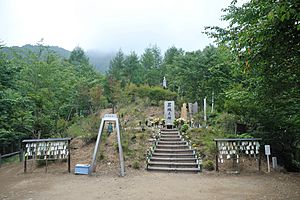
The crash also led to the opening of the Safety Promotion Center in 2006. This center is at Haneda Airport. It helps train airline employees about safety. It also has displays about the crash. You can see parts of the plane and things that belonged to passengers, like farewell notes. The center is open to the public by appointment.
The captain's daughter, Yoko Takahama, later became a flight attendant for JAL.
In 2022, an oxygen mask from Flight 123 was found near the crash site. This happened during road repair work.
Images for kids
-
JA8119, the Boeing 747 involved in the accident, at Haneda Airport in 1984
-
Cenotaph (memorial) for Flight 123
See also
 In Spanish: Vuelo 123 de Japan Airlines para niños
In Spanish: Vuelo 123 de Japan Airlines para niños


